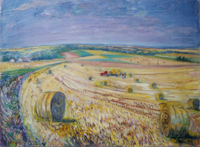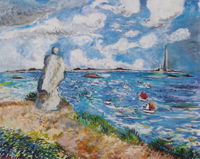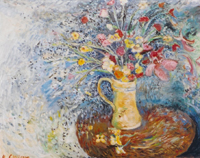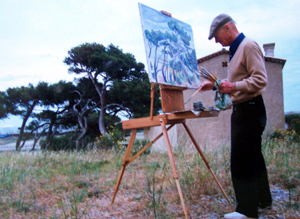|

Landscapes

Marine

Still Life
|
Biography
 Lavergne showed a gift for painting at an early age. At age
fourteen he was admitted to Georges Desvallieres' and
Maurice Denis' Atelier d'Art Sacre in Paris where the
Post-Impressionist heritage was passed on to him. He later went
on to study at Beaux Arts. He received scholarships from Maison
Descartes in Amsterdam and from the Belgian
Government. Lavergne showed a gift for painting at an early age. At age
fourteen he was admitted to Georges Desvallieres' and
Maurice Denis' Atelier d'Art Sacre in Paris where the
Post-Impressionist heritage was passed on to him. He later went
on to study at Beaux Arts. He received scholarships from Maison
Descartes in Amsterdam and from the Belgian
Government.
In Paris he has exhibited, year after year, in numerous prestigious
Salons. They include: the Salon d'Automne, Salon des Jeunes Peintres,
Salon International des Beaux Arts, Salon des Artistes Francais and
Salon des Independants (of which he is a permanent member). Numerous
galleries in Paris, Belgium, Algeria, Austria and the United States
have and continue to exhibit and represent his work. In Paris several
well-known Galleries have represented his work. One of the best-known
was the Gallerie Bosc owned by Petrides, Utrillo's exclusive agent.
Mrs. Petrides represented Robert Lavergne's work from 1966 until the
closure of the Bosc Gallerie in 1975.
Mr. Lavergne has been selected three times for the Prix Fenon and
three times for the Prix Othon Friesz. The
outstanding quality of Lavergne's art has been confirmed with his
recognition by the world-renowned and respected
Benezit. In addition, his work can now be seen in the permanent
collection of major French Museums such as the Toulouse Lautrec Museum
(Albi), and the Reims Museum.
For the last ten years, Lavergne has been represented in the United
States by very fine galleries, first in New
Orleans by Lillian Schon Small Fine Arts (1988-91) and later, from
1992 to 1997 by Gallery Michael, located in Beverly Hills (Los
Angeles). Gallery Michael is known to be the most powerful dealer of
French Art on the West coast. This year, he exhibited at Chrysalis
Gallery, in South Hampton (N.Y.).
FIRST PERIOD
The first period covers roughly the years from 1945 to 1970. Robert
LAVERGNE paints in darkish tones. He mainly
produces landscapes, still life studies, and a few portraits. This is
a realistic period during which he closely
follows his subject matter. A certain predominance of dark colors such
as brown earths in his paintings results in a
strength and density which does not exclude the subtle use of light.
This somber period may have been the result of visible and invisible
scars left by the war. We will note that, with
the passage of time, this relative "darkness" shall disappear and that
light will be increasingly present in Robert
LAVERGNE's work.
SECOND PERIOD
Several new developments characterize the second period, which extends
from 1970 to 1980. Showing evidence of a
concern with space, Robert LAVERGNE produces more landscapes than
still lifes and portraits. The Artist places his
subjects in larger fields of vision, where depth perception relies
more on a choice of colors and values than the
geometrical rules of perspective. Space seems to be conceived as a
fundamental building material in its own right, its treatment being
essentially different from that which classical technique and
tradition command. At the same time lighter colors and more open
compositions seem to indicate a more cheerful mood for this period.
THIRD PERIOD
The third period, extending from 1980 to the present, seems to
constitute a logical development of the previous period.
The colors gain in intensity, lightness and warmth. Robert LAVERGNE
distances himself from his subject matter,
freeing his inner vision. This evolution makes for a stronger and
better expression of the Artist's emotions.
Every Artist struggles toward an inner liberation of the mind through
the expression of his craft. We can well say
that Robert LAVERGNE, without ever leaving the canons of post
impressionism, exemplifies this process, well along on
the road to complete maturity.
|